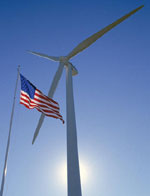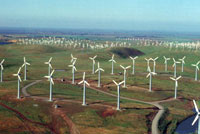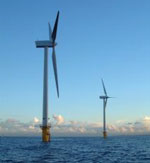Look there, friend Sancho Panza, where 30 or more monstrous giants rise up, all of whom I mean to engage in battle and slay, and with whose spoils we shall begin to make our fortunes. For this is righteous warfare, and it is God’s good service to sweep so evil a breed from off the face of the earth.”
“Look, your worship,” said Sancho. “What we see there are not giants but windmills, and what seem to be their arms are the vanes that turned by the wind make the millstone go.”
It has been four centuries since Cervantes penned Don Quixote and finally, life is imitating art. The seemingly absurd plot device of one of Western literature’s most acclaimed works — the idea that windmills could be seen as monstrous giants — has been reincarnated, in very literal ways, in the friendly, touristy, distinctly un-Spanish climes of Cape Cod, Mass.
The present-day controversy over windmills is as spirited and surprising as the one Cervantes conjured between Panzo and Quixote: One side sees windmills as a pragmatic way to provide the world with cheap, pollution-free electricity and help curb global warming. The other sees them as ugly beasts that can slay birds and sully pristine vistas. And then, of course, there are the people in between — those who advocate wind power and the larger renewable energy movement, but caution that windmills can pose serious economic and environmental setbacks to the communities where they are located. Yet even these in-betweeners speak of windmills as threatening industrial machines — a far cry from the eco-friendly, flower-power image most often associated with clean energy.
The great wind controversy has been churning ever since the 1980s, when a massive, 7,000-turbine wind farm in Altamont, Calif., was found to be a killing field for migrating birds. But now the controversy is reaching a crescendo, as energy company Cape Wind Associates LLC seeks to erect a phalanx of 170 40-story (400-foot-tall) wind turbines on Horseshoe Shoal, a shallow portion of Nantucket Sound, off the coast of Massachusetts.

When the wind blows.
Photo: NREL.
If it is successful, the Cape Cod wind project would be the nation’s first-ever offshore wind farm and its largest renewable energy installation. At maximum production, the farm would be capable of generating a whopping 420 megawatts of electricity, enough to supply three-quarters of the average total power demand of Cape Cod and two islands off its shores, Martha’s Vineyard and Nantucket. Although power generated by the so-called wind park would be funneled into the New England electricity grid (and wouldn’t technically supply Cape Cod alone), the project would still prove to the rest of the nation that a community like the one in question, which has 250,000 residents, can theoretically be nearly energy-independent — no small feat at a time when global oil supplies are seriously threatened. “This project addresses the biggest problems of our time: global warming and America’s crippling dependence on foreign oil,” says Jim Gordon, head of Cape Wind Associates.
But here’s the snag: The wind farm would be located within 13 miles of the shores of two of the most coveted and environmentally protected resort islands in the nation. These shores happen to be the summer playgrounds of the rich and famous, many of whom are wealthy Democrats who donate large sums to environmental organizations. A number of areas within Cape Cod and the islands have some of the most rigorous local development codes and habitat protections in the nation, and the people there — locals and summer visitors alike — share a deeply rooted environmental ethos.

Windmills in Altamont, Calif.
Photo: NREL.
Moreover, the proposed site is located near a major migration route for dozens of bird species. Thus the developers of the wind project are facing resistance not only from those who don’t want to sully their costly ocean views, but also from local environmental activists who are concerned that migrating birds will be killed and local sea life disturbed by the construction of the wind farm, which would entail driving 170 poles, each 20 feet in diameter, 80 feet into the seabed. Sailors and fishers also worry that it will be difficult to navigate their boats and drag-nets among the maze of 170 pylons spaced a half-mile apart.
It’s a fascinating debate, and one sufficiently complex to give even the most passionate alternative energy advocate or the most devout bird-lover and beachgoer pause. As one of those alt-energy fanatics who decorates her office walls with maps of U.S. wind and solar resources, I belong firmly in the former category — and yet, having spent many summers as a kid on the beaches of Cape Cod, I sympathize with fears about how this massive installation will affect both nature and culture in the area.

Cape (Cod) fear.
Nothing illustrates the complexity of this conundrum better than the way it has divided the activist community. On the anti-wind-farm side, you have the Humane Society, Massachusetts Audubon Society, the International Fund for Animal Welfare, and the International Wildlife Coalition; on the pro-side, Greenpeace, the Union of Concerned Scientists, and the Conservation Law Foundation.
At the center of the whole mess is a regulatory vacuum. This is, after all, the first time a wind farm of such a scale and location has been proposed, so there’s no existing framework for the environmental review of offshore wind projects. The U.S. Interior Department has established environmental review processes for offshore oil and natural gas rigs, which typically take about 10 years to get permitted, but the questions that surround offshore wind farms are completely different.
Cape Wind Associates argues that because a wind farm does not involve minerals extraction, it should not be compared to an offshore oil rig or be subject to the same kind of exhaustive permitting process. But company leaders do consider themselves environmentalists — as bird-, sea mammal-, and view-friendly as the next guy — and they are committing to both a federal-level review as well as the most rigorous state-level review process required for all major developments, including industrial power plants. Once these review processes are complete (in about a year), the U.S. Army Corps of Engineers will weigh the results against other concerns, such as fisheries impacts and navigation hazards, in deciding whether to issue the permit that will greenlight the project. If the permit is granted, nothing would prevent Cape Cod Wind Associates from moving ahead with the project from a regulatory standpoint, but it could still be stalled by bad press or lawsuits. The company has commissioned Geo-Marine, Inc., to conduct a two-year radar study tracking the migration patterns of all the birds that fly near and over the site. That study is already halfway complete. The opposition, however, feels the review process should be longer, claims the company is cutting corners, and objects to the fact that the project is being overseen by the Army Corps, which has a sketchy environmental track record.
Regulatory Reform
Environmental lawyer Robert Kennedy, Jr., a key figure among those opposed to the project, also argues that the company has failed to conduct a thorough cost-benefit analysis from the standpoint of the locals. “The economic burden this project imposes on the Cape Cod community is enormous — the injury to marinas, the injury to beaches, the injury to property values.” Take, for example, the boating community, says Kennedy: “Why would they want to spend the three weeks of their vacation paddling around in the middle of an industrial zone when they could go someplace pristine?”
Kennedy argues that the regulatory process should stipulate royalties and benefits to the locals who might suffer economic setbacks from the development. “What [Cape Wind is] trying to do is circumvent that whole regulations process and privatize a heavily utilized public trust resource and turn it into a private profit-making industrial facility. If you can do that offshore with a wind plant, why not build a hotel on stilts? Why not build a liquefied natural gas processing plant? A casino? You can build anything you want if you can build this. … If you let this go through, you can’t name me a beach that’s not going to have wind farms [or some other development] in front of it.”
The regulatory question is a critical one to resolve, especially since the Cape Cod project is one of several wind farms now being proposed off U.S. shores. But the very notion that any kind of alternative energy development could be a cause for economic opportunism can be seen as reason to celebrate, given that for decades renewable energy has been maligned as an economic sinkhole. The U.S. wind industry has grown dramatically in recent times, to the tune of 40 percent per year for the last four years; last year, it grew by a whopping 50 percent. By 2000, wind had become cost-competitive with traditional energy sources. It now costs roughly 3 to 6 cents per kilowatt-hour, while traditional energy typically costs 4 to 8 cents per kWh. Wind’s economic promise is so undeniable that General Electric bought out Enron Wind, one of the only legitimately profitable divisions of Enron. And even the notoriously fossil-fuel-friendly Bush administration has proposed extending existing production tax credits for wind producers to continue stoking the industry’s development.
In short, from an economic standpoint, wind development is currently the holy grail of alternative energy development, which means it’s one of the most powerful existing solutions to the country’s dependence on foreign oil. It is also one of the most powerful existing solutions to global warming, given that fossil-fuel power plants are responsible for nearly half of U.S. carbon emissions.

The new turbine generation.
Photo: NREL.
“This controversy all boils down to how you balance your concerns,” says Nathanael Greene, a wind expert at the Natural Resources Defense Council who has been researching the Cape Cod project. “Environmentalists are unanimously in favor of reducing greenhouse emissions and protecting birds and pristine vistas and so forth. But we have to make tradeoffs. We have to decide what’s most important.”
Greene says that he and the NRDC will not take an official position on the project until the review processes are complete, but he’s hopeful that no significant environmental threats will be discovered. Indeed, it seems fairly clear that many of the environmental objections to the wind farm are unfounded. There’s little evidence, for instance, that the drilling itself would deafen whales, seals, or sea turtles (as claimed by a leading opposition group, Alliance to Protect Nantucket Sound), and the chance that fish spawning grounds would be significantly disturbed by debris from construction and changing currents caused by the presence of the pylons is very slim, according to existing research on offshore wind installations in Europe. In addition, concerns that the farm would disrupt the fishing industry don’t hold water, because the turbines would be spaced too far apart to pose a problem. The only fishing likely to be interrupted would be the kind that entails dragging huge nets along the seafloor — a method that poses a significant threat to fish stocks, and is therefore a good thing to disrupt.
What about the birds, then? Many species of birds cross Nantucket Sound by the thousands during migration, according to the Massachusetts Audubon Society, and some rare or endangered species, like the roseate tern, frequent the waters. Existing avian studies show that migrating songbirds typically fly between 1,000 and 5,000 feet off the ground, which would put them safely above the height of the turbine blades. But Jessica Almy of the Cape Wildlife Center, a program of the Humane Society, raises legitimate concerns: “We don’t know enough yet about the details of their flight patterns. Do they fly that high when crossing water? And how soon after taking off from Cape Cod do they reach cruising altitude? And does weather affect the height at which they fly?”
For the Birds
Cape Wind Associates hired Avian Radar to answer such questions, but Almy and the state’s Audubon Society say that any bird review shorter than three years will not be accurate, because the unusual warmth of this past year’s weather might have affected bird behavior. “I am a big wind advocate,” says Almy, “But my concern is that this project could be destructive enough that it will become a very ugly poster-child for the wind industry and hurt more than help future wind projects.”
As it happens, the wind-energy movement already has an ugly poster-child: Altamont, which almost single-handedly gave rise to the fear that wind turbines are bird cuisinarts. Birds did indeed die at Altamont — 183 of them between 1990 and 1992 (the only years for which there are definitive figures), including five bald eagles. But since then, significant changes have been made to wind technology. “Altamont is an anomaly,” says Paul Kerlinger, a New Jersey-based ornithologist. “Since Altamont, bird studies have been conducted in over a dozen states ranging from Tennessee to Minnesota and not one has shown that bird populations have been affected. They show that on average no more than two birds have been killed per turbine per year.”
Standard turbines are now larger and move more slowly than the technology used at Altamont. The blades on the Altamont turbines were only 28 feet long, but modern blades are usually more than 100 feet long, which means they can turn more slowly to produce the same amount of energy. The blades now spin at an average of 16 rotations per minute, whereas those at Altamont spun at 72 rpm. The slower-moving blades are far easier for birds to see and avoid. Furthermore, the windmills at Altamont were spaced roughly 25 feet apart, whereas those at the Cape Cod installation would be one-third to one-half mile apart. Also, the pylons of the wind turbines at Altamont were made of a latticework structure that the eagles actually used for nesting sites; now, pylons are just a solid tube.
As Kerlinger points out, conventional energy technologies are hardly a better solution when it comes to wildlife. “What about bird and animal mortalities associated with natural gas turbines and oil-burning turbines? Anytime you turn on the lights, something gets killed.” Birds fly through pollution clouds and acid rain, for instance, and get sucked into vents in turbines and incinerated. But the opposition is not convinced. They note that, despite the technological upgrades, the blade tips still move at 170 miles an hour, posing an undeniable threat to birds. And, they say, the Cape Cod project would be far larger than most of those that have been evaluated since Altamont.
At the end of the day, perhaps the most tenable and convincing fears of those opposed to the project pertain to the coveted ocean views. On clear days, the wind farm would be visible from many of the beaches of Cape Cod, Martha’s Vineyard, and Nantucket, the horizon broken by the blades of the turbines. Granted, the disruption would not be huge; if you extend your arm in front of you and stick up your thumb, the turbines would be about the height of your thumbnail. Still, if you like the seamless continuity of the horizon line, that perfect vanishing point where the ocean meets the sky — a place on which many of us are wont to mediate — you would find the interference somewhat disturbing.
“They ought to push these things offshore where they’re not interfering with local economies,” says Kennedy. “But their argument is it’s too expensive. Their profit margins are going to go down the farther out they push it.”
The Answer, My Friend, Is …
Gordon of Cape Wind Associates says it’s more extreme than that; if the company were to site the project in the Atlantic Ocean, which lies just beyond the Nantucket Sound, the cost would be prohibitive. In the open ocean, the waters are very rough and the seabed is much deeper, which would make it far more expensive to maintain and secure the turbines. “Already it’s about twice as expensive to put wind installations on water than land. And the bottom line is we have to have a financable project,” says Gordon. “Windfarms in Europe have not had to be profitable because their government is heavily subsidizing [them] and guaranteeing markets.”

An offshore wind
project in the U.K.
Photo: AMEC.
Given the prevailing energy policies of the Bush administration, it doesn’t seem reasonable to put the project on hold while lobbying for more subsidies. For those who consider global warming an urgent concern, the tradeoffs for this project seem relatively benign. In the end, like Quixote, the opposition might have to come to terms with the fact that windmills, albeit nettlesome, are not in fact destructive beasts. On the contrary: Right now, they may be the best solution we’ve got.

